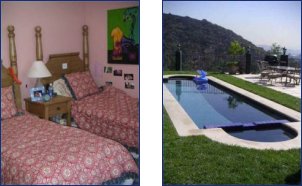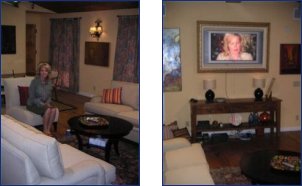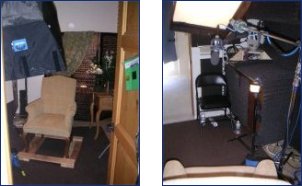For its new second season that began broadcasting this week, Bunim-Murray’s “Starting Over” daytime reality series is getting its own chance at a new start by vacating its original Chicago-based home, and taking root in a Spanish-style $6 million home nestled in the Hollywood Hills.
|
ADVERTISEMENT
|
In this article, Brooke recounts her exclusive interviews with the life coaches and executive producer and discusses the strategy behind the design of the new reality TV house.
My two hour visit began at 10 am, when I parked my car on a small side street in Hollywood, and met Amanda, a production assistant that had been assigned to shuttle guests from their car to the house.
 |
| The view of the house as the car approached from the street. Inset, a smoggy, albeit spectacular view of Los Angeles |
Amanda dropped me off and I was whisked away by another P.A. into an open-air patio, where I waited for my designated tour guide. I wandered over to the balcony and was awe-stricken by the spectacular view of Los Angeles, even though it was heavily obstructed by smog that day.
Life Coach Rhonda Britten, returning from season one, soon appeared beside me and invited me to follow her around the house. As I followed her in, she explained the motivation behind the big move to the West coast. The most emphasized reason was the weather. She explained that viewers should not have to feel unsettled watching an episode filmed during a snowy winter in Chicago, but not aired until the spring season.
 |
| Rhonda sits on a couch in the living room. Behind her, you can see through the dining room into the kitchen. |
I asked Rhonda to comment on the choice of décor, and she stated that bright colors were intentionally chosen to uplift the guests, and that all artwork was obtained only from women artists in order to reinforce the theme of female empowerment.
Rhonda took me past the only phone in the entire house, situated in the middle
 |
| At left, a table with phone, located in a very public part of the house. At right, a not-so-hidden camera is used to capture emotional moments on the phone. |
As we entered the smallest bedroom, Rhonda explained the strategic assignment of roommates within the house. She told me, “We put people together that will ignite each other”. For example, Kim, who is used to the comforts afforded to the wealthy, was forced to share the smallest bedroom, despite her request upon her arrival to the house to have the largest room to herself.
 |
| At left, the smallest room in the house, which well-to-do Kim is forced to share with a roommate. At right, the pool and deck that overlook the city of Los Angeles. |
Boards of Review, previously held in the Chicago living room, now will be held in a separate room, in which the cast members are only allowed to enter upon invitation from the crew. As Rhonda led me to this room, she explained that this change will add a more “official feel” to all of the meetings by having one such designated room. I also noted that it would minimize the area of the house that the cast was allowed to occupy on a day-to-day basis (further increasing proximity between housemates).
 |
| At left, Rhonda sits in her "usual chair" in the meeting room. At right, the monitor in the meeting room will be used to replay scenes for the house guests during meetings. |
My visit with Rhonda drew to a close when Dr. Stan J. Katz, the new on-site clinical psychologist, walked in and offered to meet with me for a few minutes. As the first male addition to the coaching team, he revealed that the cast was initially apprehensive about his presence in this feminist environment. However, he says the women eventually sought him out for not only his scientific expertise, but also as the only subject onto whom they could project their issues with men.
 |
| Producer Millee Taggart-Ratcliffe and a director discuss a scene in the control room |
 |
| Producer Ratcliffe can oversee the entire house at all times from a monitor on the desk in her office |
After the tour of her office, Millee showed me the closet-size confessional room, and expressed that “It’s astonishing how getting put in this little room can make some people spill their guts”. Opposite the confessor’s plush armchair is a foldable chair that is reserved for the producer.
 |
| The confessional room (or closet), where contestants sit in a comfortable chair with facade behind them while being questioned by a producer in a folding chair. |



